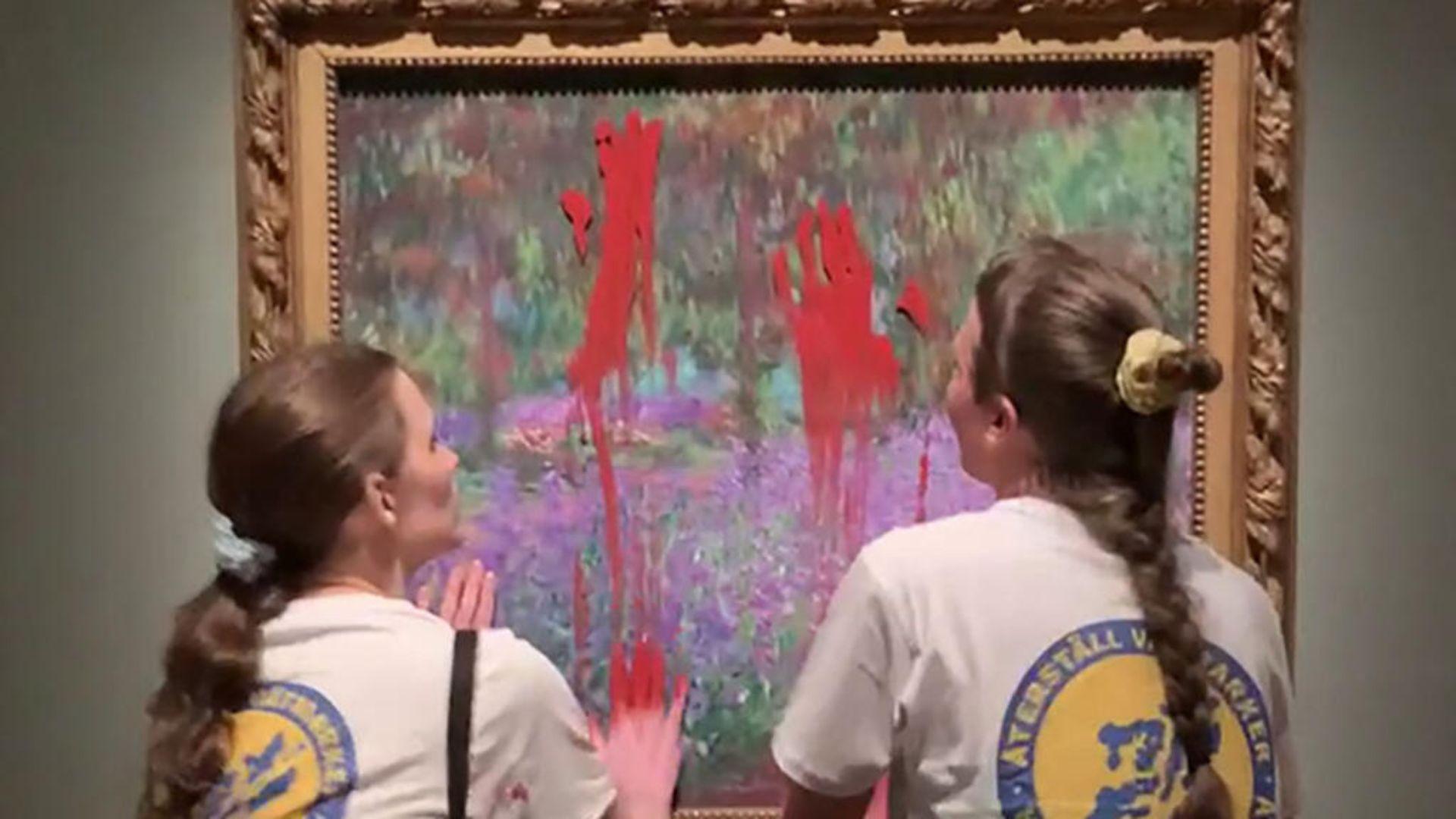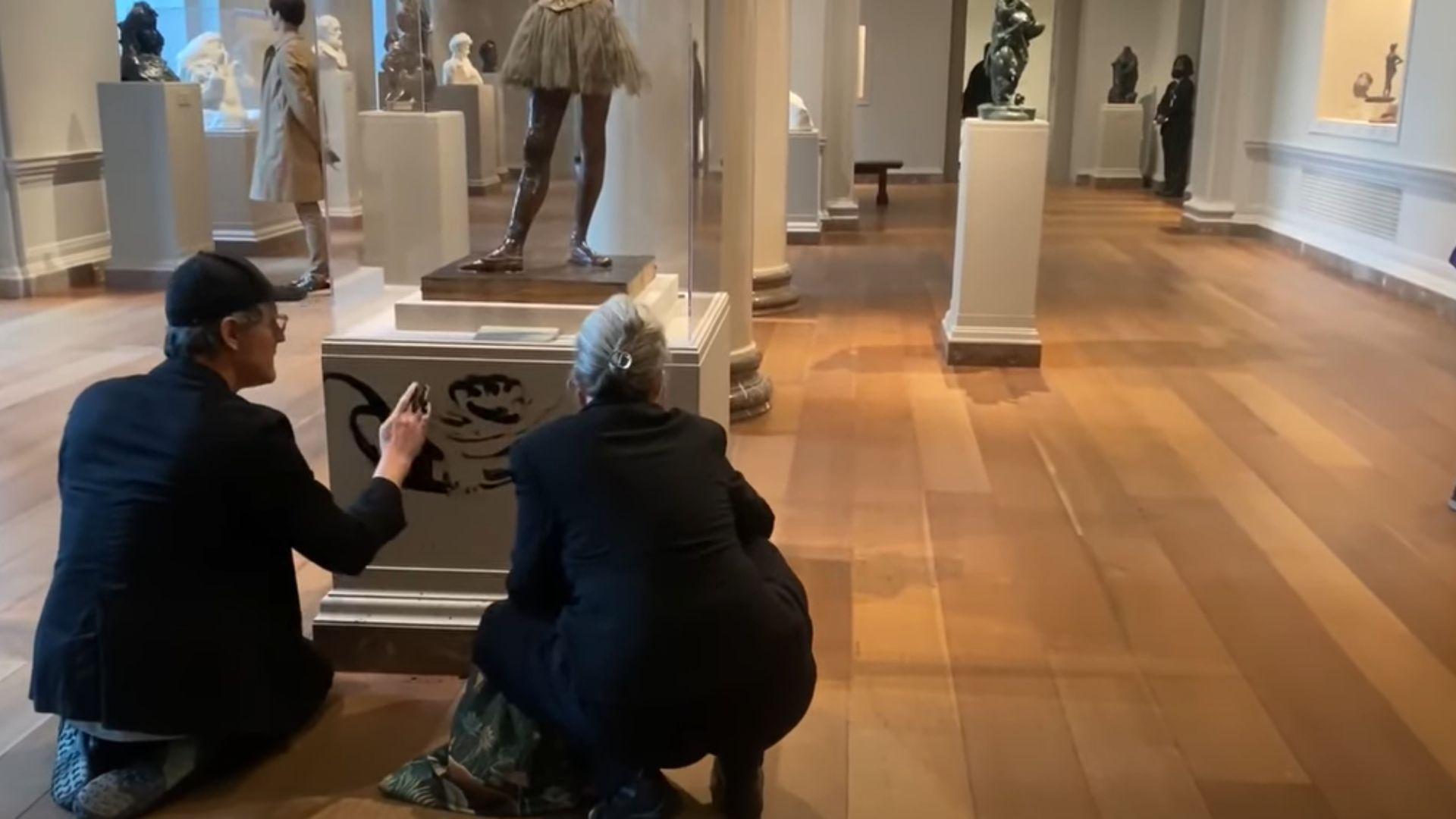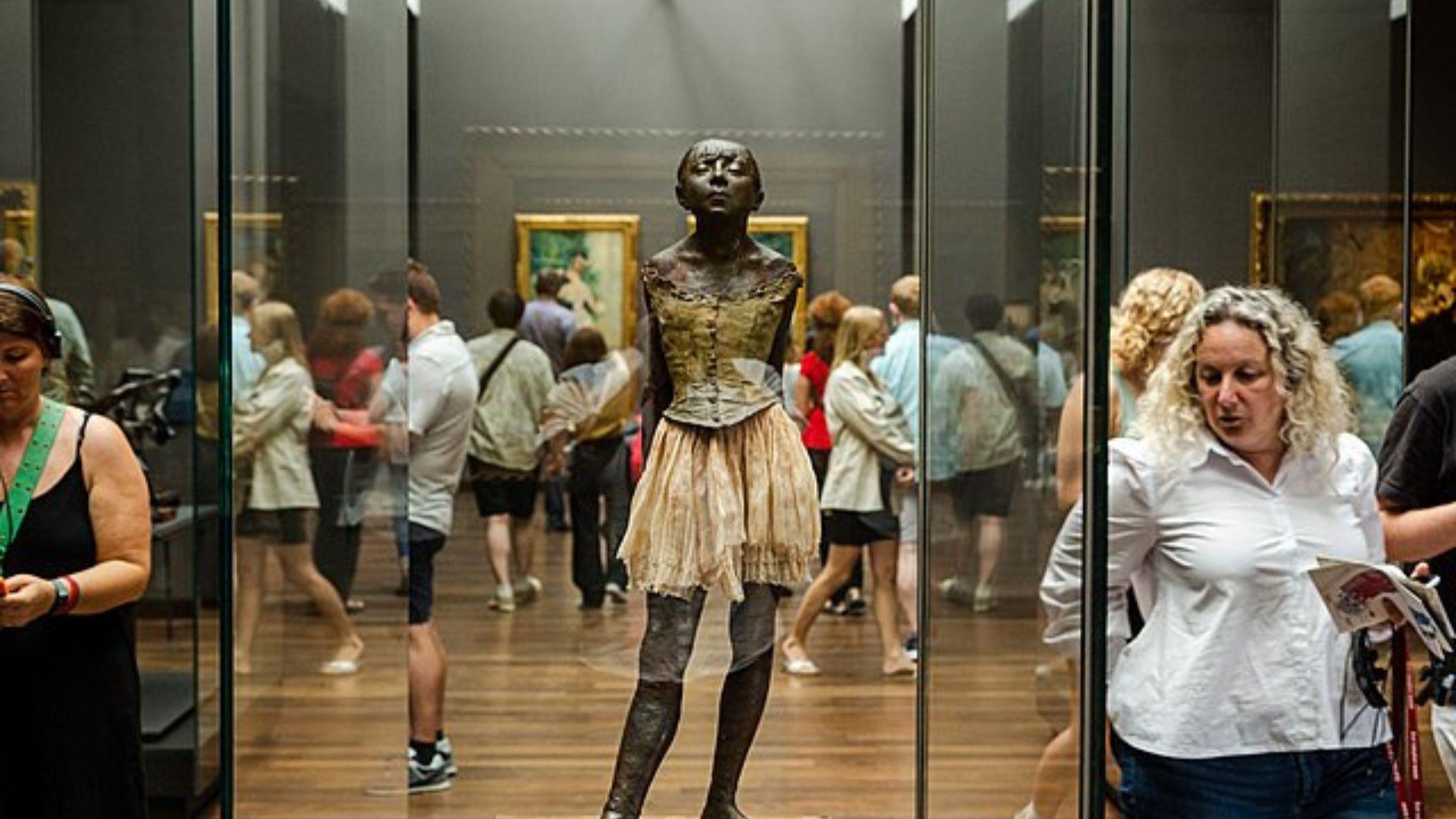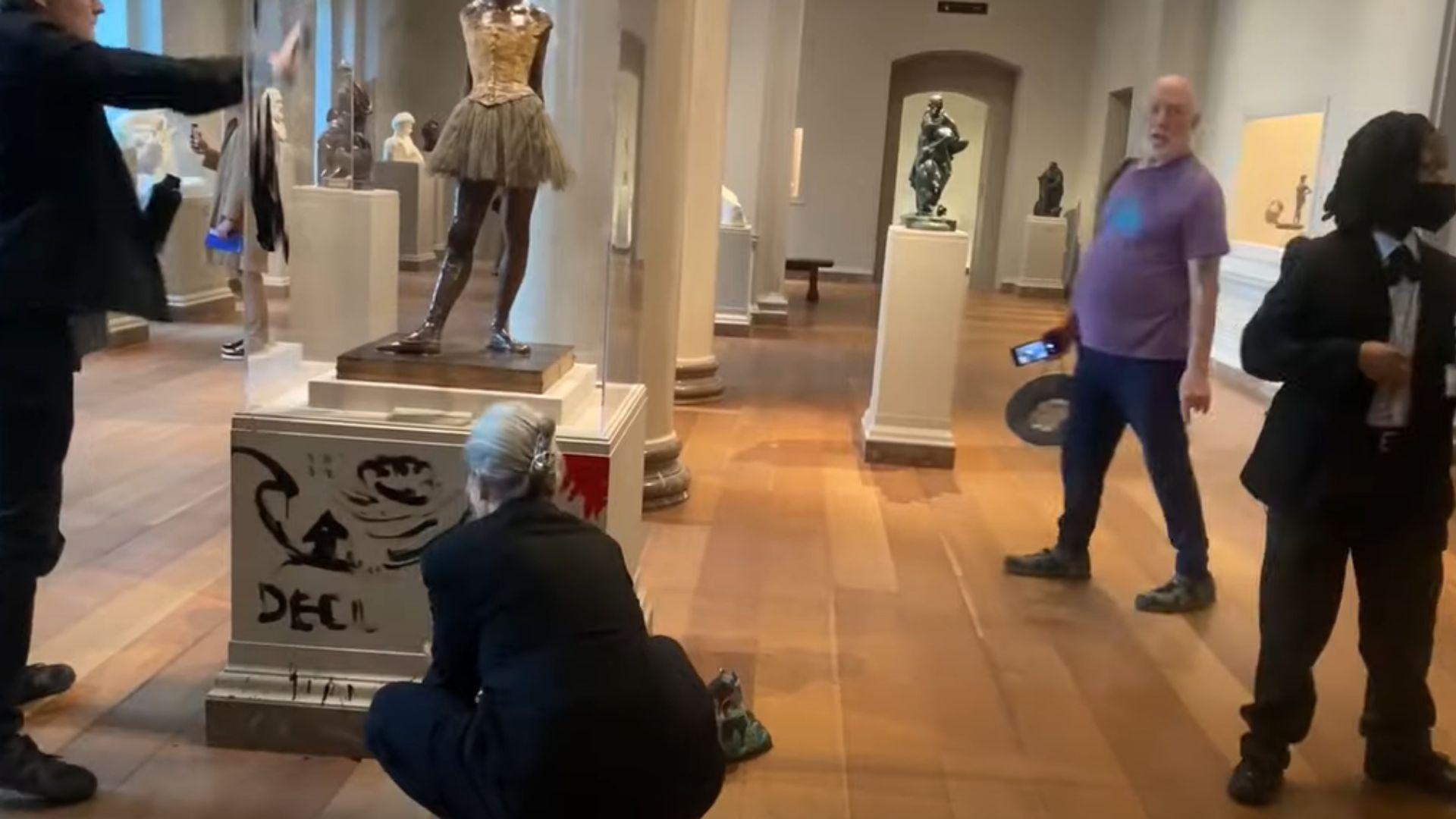Climate Activist Receives Prison Sentence After Vandalizing 142-Year-Old Work of Art
A climate activist who vandalized a piece of art in the National Gallery of Art in Washington will face a 60-day prison sentence.
She has also been ordered to pay a fine for damaging the piece. Meanwhile, her accomplice is set to appear in court in August 2024.
Climate Activists Are Destroying Art
Climate activists have recently taken to destroying artwork with paint, with one pair smearing red paint on a Monet painting at the Stockholm Museum.

Source: @WtxNews/X
While that painting remained unharmed as it was behind a glass case, they said they did it because the painting depicted a garden that the activists believe the likes of will no longer exist if climate change continues.
Why Climate Activists Are Targeting Art
Many of these activists are not there to destroy the art. Instead, they are there to simply make a scene, drawing museum-goers and the internet’s attention to the Earth’s rising temperatures, intensifying wildfires, and approaching famine due to droughts.

Source: Markus Spiske/Pexels
While Smith was criminally charged for defacing “Little Dancer Aged Fourteen,” activists’ are leaning into the provocative nature of art vandalism.
Joanna Smith Destroyed a Wax Sculpture
One of the more recent cases of climate activists destroying art in the name of climate change was done by Joanna Smith, who destroyed a wax sculpture in April 2023.

Source: KPRC 2 Click2Houston/YouTube
The sculpture is known as “Little Dancer Aged Fourteen” by Edgar Degas. Smith pleaded guilty to the crime during a hearing in December 2023.
Smith Had Targeted "Little Dancer Aged Fourteen"
Smith worked alongside an accomplice to carry out vandalism.

Source: Adrian Scottow/Wikimedia Commons
The pair researched the sculpture before vandalizing it at the National Gallery of Art in Washington.
The Importance of the “Little Dancer Aged Fourteen”
“Little Dancer Aged Fourteen,” is the only sculpture that Degas would ever exhibit in public, and it has become one of the most beloved and well-known works of art.

Source: National Gallery of Art, Washington, Collection of Mr. and Mrs. Paul Mellon/Photograph of Ms Peck by Matthew Karas
The National Gallery of Art calls the statue groundbreaking, writing, “The liberating idea that any medium or technique necessary to convey the desired effect is fair game may be traced back to this sculpture.”
Smith Hid the Paint in Water Bottles
Smith managed to hide the paint from security, those working in the art gallery, and others in the gallery by hiding the paint in water bottles.

Source: KPRC 2 Click2Houston/YouTube
One person posted a video of the act on X, where Smith gave a speech, saying that climate change is destroying human expression.
Supporters Rally Behind Smith
Last June, around 20 members of Extinction Rebellion NYC and Rise and Resist protested the charges against Martin and Smith at the Metropolitan Museum in New York.

Source: Vincent M.A. Janssen/Pexels
Lydia Woolley, a climate activist in the group, interrupted a Broadway performance last month, shouting: “Don’t forget about Joanna Smith. Don’t forget about Tim Martin. Don’t forget about the truth tellers. This play doesn’t end when you leave the theater.”
A Maximum Sentence for Vandalism Is 5 Years
The maximum prison sentence someone can receive for vandalism is 5 years.

Source: Tingey Injury Law Firm/Unsplash
However, Smith was only sentenced to prison for 60 days.
Supporters Petition for Smith to Have a Light Sentence
More than 1,000 people signed a petition before Smith’s sentence hearing, urging Judge Amy Berman Jackson to give Smith a lighter sentence as her actions were part of activism.

Source: Library of Congress/Flickr
“The right to protest in the U.S. and the history of symbolic, nonviolent civil disobedience actions are well-documented,” the letter to Jackson accompanying the petition states. “However, these charges and this case appear to disregard past precedents and respond to these recent acts in an excessively severe manner.”
Smith Received Community Service Over a Prison Sentence
On top of her prison sentence, Smith was also sentenced to community service.

Source: Cottonbro Studio/Pexels
She will perform 150 hours of community service, 10 of which will involve cleaning graffiti. She also received a sentence of 24 months of supervised release and a $4000 fee in damages.
Smith Is Part of the Declare Emergency Group
Smith and Timothy Martin, her accomplice, are part of the Declare Emergency group.

Source: @decemergency/Instagram
They believe the US Government is complicit in continuing to use fossil fuels as a way to kill the planet, with many others in the group also defacing objects in the name of fighting climate change.
Declare Emergency Rose Awareness of Smith’s Sentencing
Declare Emergency posted about the arrest at the time, outlining what had happened and why it had happened.

Source: @decemergency/Instagram
The post also said Smith and Martin could face a maximum fine of $500,000 and posted a link to a legal fund where people could donate.
The Sculpture Is Removed for Repair
In a statement released by the DC United States Attorney’s Office, the National Gallery had to remove the sculpture from public viewing for 10 days as they repaired the $4,000 in damages.

Source: Anne Petersen/Flickr
The team behind the restoration calls the vandalism done to art by climate activists could threaten cultural heritage and historical memory.
The Sculpture's Unstable Future
“She is one of the most vulnerable and fragile works in our entire collection,” said Kaywin Feldman, director of the National Gallery of Art, in a statement to NPR.

Source: Fiji Mermaid Project/Joseph Cress
Feldman continued: “I cannot overemphasize how the violent treatment of her protection barrier, repeated slamming, and vibrations, have forever jeopardized her stability.”
Climate Activist Target Other Famous Art Works
Climate protest toward art has increased over the last few years around the world. Last year, Georgia B. Smith, a climate activist with the Just Stop Oil and Extinction Rebellion–who has been using cake, soup, paint, and glue to capture the attention of museum visitors–threw soup at a Van Gogh painting.

Source: Markus Spiske/Pexels
“I saw this action at an art museum… and it was a controversial action, but I know why they’re doing this. I feel the same desperation these people are feeling,” Smith said.
Art Vandalism Has Been Happening for Centuries
Defacing art is not a new protesting tactic. Many religious movements have destroyed art depicting other religions in an attempt to wipe out the history of any other religions’ existence in the territory.
![Print of the destruction in the Church of Our Lady in Antwerp, the "signature event" of the Beeldenstorm, 20 August 1566, by Frans Hogenberg[1]](https://images.pastchronicle.com/2024/05/feed7493-beeldenstorm.jpg)
Source: Wikimedia Commons
While some pieces of art were hidden away and are still being discovered, much of history’s greatest works of art are lost to the hands of fear and hate.
Women Suffragette Stabs an Art Piece
In the early 1900s, a suffragette named Mary Richardson slashed Diego Velázquez’s “Rokeby Venus” in an attempt to draw attention to women’s demands to vote in Britain.

Source: Wikimedia Commons
“I have tried to destroy the picture of the most beautiful woman in mythological history as a protest against the Government for destroying Mrs. Pankhurst, who is the most beautiful character in modern history,” Richardson once said.
Japanese Woman Spaypaints the “Mona Lisa”
In 1974, Japanese woman Tomoko Yonezu spray painted Leonardo da Vinci’s “Mona Lisa” while the art piece was on tour from the Louvre in Paris to the National Museum in Tokyo, which had instituted crowd control that disability activists deemed discriminatory.

Source: Wikimedia Commons
While Yonezu was fined for her actions, the National Museum was forced to set aside a day for disabled museum-goers to visit the painting.
Why These Art Museums Are Being Targeted
According to National Geographic, climate protests are targeting museums like the American Museum of Natural History and Amsterdam’s Van Gogh Museum because “these cultural institutions aren’t telling these stories.”

Source: Markus Spiske/Pexels
These museums have been pressured in recent years to cut funding received from fossil fuel companies, which are the greatest contributors to the climate crisis.
Support for the Protestors
“Protest is like theater,” Favianna Rodriguez, an artist and climate activist, said in support of these protestors. “It’s the creation of a counter-narrative.”

Source: Freepik
“A lot of these museums are holding things that were stolen during colonization—sacred, sacred objects,” Rodrigeuz said. “These places are not just contested by climate activists. There’s been a lot of controversy around their collections, how they’ve collected, and what kind of point of view they have shown.”
Non-Profit Museums Are Suffering
Climate activists may be trying to make a statement, but the non-profit museums and art galleries whose items they destroy suffer the most.

Source: KPRC 2 Click2Houston/YouTube
They have to pay to restore the artwork to its original form, even if the case the artwork is in has been defaced, which can be catastrophic and potentially cause them to close if they cannot get the funds.
More Security Measures Are Needed To Stop Climate Activists
The only way to stop climate activists from continuing to deface artwork is to increase the security measures in art galleries and museums.

Source: Scott Webb/Unsplash
This comes after people on both the right and the left lost their support for these climate activists, and while climate change is important, their efforts have gone too far.
Stronger Penalties for Climate Activists
It has also been suggested that climate activists should face stronger penalties for defacing art.

Source: Niu Niu/Unsplash
This is in the hope that it will deter future methods to deface art, regardless of whether it is in the name of climate change.
